

FlipKlipp – skapa och dela öppna lärresurser. Femte veckan med flippat klassrum: För- och nackdelar. BRA PRESENTATION. The Ultimate Guide To Flipping Your Classroom. Note: This is part 1.

“A reversed teaching model that delivers instruction at home through interactive, teacher-created videos and moves “homework” to the classroom. Moving lectures outside of the classroom allows teachers to spend more 1:1 time with each student. The Foundations of Flipping. Best Practices for Teaching Today "Kids don't show up to learn new stuff.

They show up to apply the things they've learned at home. " Aaron Sams As a new teacher, I often seek advice from other mentors. Because of the strong mentors I've been fortunate to have, I feel like I've grown so much over the past few years. Research indicates that students learn best by doing (the higher levels of Bloom's Taxonomy: applying, analyzing, synthesizing, and evaluating). Flipping the Classroom. 4/27/2012 By: Teachers from around the world have adopted the flipped classroom model and are using it to teach a variety of courses to students of all ages.
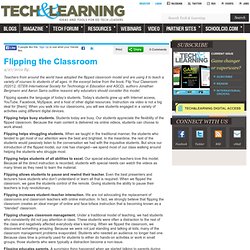
In the excerpt below from the book, Flip Your Classroom (©2012, ISTE® International Society for Technology in Education and ASCD), authors Jonathan Bergmann and Aaron Sams outline reasons why educators should consider this model. Flipping speaks the language of today’s students. Today’s students grew up with Internet access, YouTube, Facebook, MySpace, and a host of other digital resources. Instruction via video is not a big deal for [them]. Flipping helps busy students. Flipping helps struggling students. Flipped Classroom - Lesson Preparation. The Flipped Classroom: Getting Started. I recently gave a webinar on getting started with the flipped classroom.

Lots of good questions – seems like many teachers see the value in using “flipping” to redefine their classrooms. They recognize that the traditional classroom was filled with a lot of lower-order, information transmission that can be off loaded to “homework” via content-rich websites and videos. That frees up more classroom time as a center for student interaction, production and reflection. While some may think flipping is all about watching videos, it’s really about creating more time for in-class student collaboration, inquiry, and interaction. It’s also is a powerful catalyst for transforming the teacher from content transmitter to instructional designer and changing students from passive consumers of information into active learners taking a more collaborative and self-directed role in their learning. Download my slide deck for strategies, resources, lessons and links and more. Five Questions to Ask Before Flipping a Lesson. The best lecturers are more than content-deliverers.
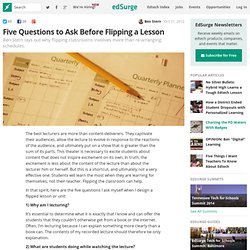
They captivate their audiences, allow the lecture to evolve in response to the reactions of the audience, and ultimately put on a show that is greater than the sum of its parts. This theater is necessary to excite students about content that does not inspire excitement on its own. In truth, the excitement is less about the content of the lecture than about the lecturer him or herself. But this is a shortcut, and ultimately not a very effective one. Students will learn the most when they are learning for themselves, not their teacher. In that spirit, here are the five questions I ask myself when I design a flipped lesson or unit:
Understanding the Flipped Classroom: Part 1. October 23, 2012.

Understanding the Flipped Classroom: Part 2. October 24, 2012 By: Pamela Kachka in Teaching with Technology Editor’s Note: Part 1 of this article looked at the history of the flipped classroom.

Today we look at what it takes for someone to teach effectively in a flipped classroom. Although the flipped classroom is garnering a lot of attention of late, simply flipping the classroom alone does not increase student success. Flipping Your Classroom With Free Web Tools - Guest Post. 5 Digital Tools For The Flipped Classroom. Hafsa Wajeeh, dtopgadgets Have you “Flipped your classroom” yet?
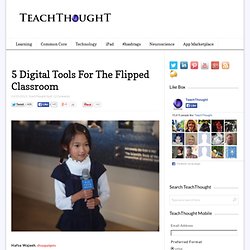
The flipped classroom is a useful technique that has moved lectures out of the class, and onto digital media. In doing so, teachers can drastically increase interaction time with their students. The Flipped Classroom: Pro and Con. In 2012, I attended the ISTE conference in San Diego, CA.
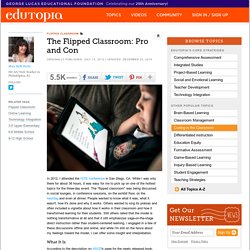
While I was only there for about 36 hours, it was easy for me to pick up on one of the hottest topics for the three-day event. The "flipped classroom" was being discussed in social lounges, in conference sessions, on the exhibit floor, on the hashtag and even at dinner. People wanted to know what it was, what it wasn't, how it's done and why it works. 7 Steps To Flipped Professional Development. 7 Steps To Flipped Professional Development by Laura Conley first appeared on gettingsmart.com Arriving home from San Diego and having just attended the ISTE (International Society of Technology in Education) conference I was scheduled to facilitate an all-day professional development for our district.
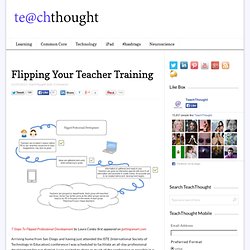
I was excited to share as much of the conference as possible in a day without overwhelming everyone. I wanted to present the information in an engaging way by modeling the use of technology instead of just handing everyone a sheet of paper with some links. I knew where those papers would end up! With this in mind I started working on a new professional development model that made sense to me and would hopefully make sense to others. What Is A Flipped Classroom? (Updated For 2012) The Current State Of Technology In K-12 7.43K Views 0 Likes What is the next device most students will soon purchase? How many schools have a digital strategy? 6 Steps To A Flipped Classroom. By Josh Corbat, TeachThought Intern Students today are vastly different from when we were in their shoes. We were brought up on the age-old tradition of lecture, practice, and assessment. Lather, rinse, repeat. Inquiry-based Learning: Explanation. What is inquiry-based learning?
An old adage states: "Tell me and I forget, show me and I remember, involve me and I understand. " The last part of this statement is the essence of inquiry-based learning, says our workshop author Joe Exline 1. Inquiry implies involvement that leads to understanding. Furthermore, involvement in learning implies possessing skills and attitudes that permit you to seek resolutions to questions and issues while you construct new knowledge.
Problem-based learning. Problem-based learning (PBL) is a student-centered pedagogy in which students learn about a subject through the experience of problem solving. Students learn both thinking strategies and domain knowledge. The PBL format originated from the medical school of thought, and is now used in other schools of thought too. The goals of PBL are to help the students develop flexible knowledge, effective problem solving skills, self-directed learning, effective collaboration skills and intrinsic motivation.[1] Problem-based learning is a style of active learning. Working in groups, students identify what they already know, what they need to know, and how and where to access new information that may lead to resolution of the problem. Meaning[edit]